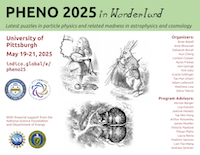Conveners
New Developments in Theory: I
- Luis Anchordoqui
New Developments in Theory: II
- Neil Christensen (Illinois State University)
We introduce a field-theory framework in which fields transform under the little group, rather than the Lorentz group, specific to each particle type. By utilizing these fields, along with spinor products and the x factor, we construct a field-theory action that naturally reproduces the vertices of the constructive standard model (CSM). This approach eliminates unphysical components,...
On generic (non-stationary) curved backgrounds, the link between Euclidean and Lorentzian signature QFT via a Wick rotation is not fully understood. In this talk, I will present a generalization to curved spacetimes of a variant of Wick rotation originally due to Zimmermann. This construction interpolates between Lorentzian and Riemannian metrics on the same underlying smooth real manifold,...
“New” physics can potentially be witnessed in two ways: firstly, by making familiar experiments more precise, and secondly, by looking for phenomena outside the familiar domain. Even though quantum mechanics (QM) has been extremely well-tested, there is room for novel, although necessarily tiny, effects.
In this talk, I will describe a framework that modifies QM slightly, using parameters...
One of the fundamental difficulties in the Lagrangian formulation of effective field theories (EFTs) is that one can redefine the fields in a theory without changing the physical predictions, e.g. scattering amplitudes. The freedom to perform field redefinitions to change the form of the Lagrangian can often obscure the physical content of an EFT. This is in fact a familiar situation in any...
Field redefinitions in effective field theories (EFTs) can involve derivatives, introducing redundancies that cannot be captured by the traditional geometry of field space based solely on two-derivative terms in the Lagrangian. To accommodate these derivative-dependent transformations, we present a geometric framework that extends beyond conventional field space to the functional manifold....
I will review developments in applying Anomaly Mediated SUSY Breaking (AMSB) as a theoretical tool for understanding the dynamics of strongly coupled gauge theories. After reviewing the general properties of AMSB, I will show what we have been able to learn when applying it to a variety of examples. Many non-trivial consistency conditions are satisfied. In the case of QCD, I will show how we...
Recent years have seen growing interest in exploring quantum information principles within particle scattering processes, both in theoretical and experimental physics. Magic, a resource that quantifies computational advantages in quantum systems, offers a distinct measure of quantumness beyond conventional metrics like entanglement. As researchers investigate the role of magic in scattering...
Realistic grand unified theories based on the exceptional group $E_6$ will be presented and their phenomenological implications explored. These include fermion masses, neutrino oscillations, proton decay and a GUT-stabilized dark matter candidate.
Spinor helicity formalism and modern amplitude techniques are powerful tools receiving strong attention. In this talk, we will show that the discrete symmetries, parity and charge conjugation, can be applied and determined completely within the spinor helicity language. We will further apply it to the production amplitude of magnetic monopoles by annihilating electric particles. On-shell...
We study the applicability of the usual finite temperature effective potential in the equation of motion of a homogeneous "misaligned" scalar condensate , and find important caveats that severely restrict its domain of validity: i:) the assumption of local thermodynamic equilibrium (LTE) is in general not warranted, ii:) a direct relation between the effective potential and the thermodynamic...
The anomalous magnetic dipole moment ($g-2$) of the electron is one of the most precisely measured quantities in the world. To push precision beyond the current record, we can no longer assume the electron is in free space. We calculate $g-2$ for an electron in a cylindrical cavity and demonstrate that the boundary correction can be measured in a near-future experiment.
Recursive constructions in amplitudes are a strong feature that requires careful analytic continuation with momentum shift to yield the full, correct, physical amplitudes. If not done systematically, an undetermined contact term would arise. We study the All-Line Transverse (ALT) shift, which we developed for on-shell recursion of amplitudes for particles of any mass. Our method allows for a...
We establish a first principles, systematic framework for determining the bubble wall velocity during a first order cosmological phase transition. This framework, based on non-local Kadanoff-Baym equations, incorporates both macroscopic fluid dynamics and microscopic interactions between the bubble wall and particles in the plasma. Previous studies have generally focused on one of these two...
We consider the possibility that gravity is mediated by “continuous spin” particles, i.e. massless particles whose invariant spin scale ρg is non-zero. In this case, the primary helicity-2 modes of gravitational radiation on a Minkowski background mix with a tower of integer-helicity partner modes under boosts, with ρg controlling the degree of mixing. We develop a formalism for coupling...

